List of Indian flags
| Wikimedia Commons has media related to Flags of India. |
This is a list of flags used in India. For more information about the national flag, visit the article Flag of India.
National flag
| Flag | Date | Use | Description |
|---|---|---|---|
 | 1947–present | National flag of India | A horizontal tricolour of saffron at the top, white in the middle, and green at the bottom. In the centre is a navy blue wheel with twenty-four spokes, known as the Ashoka Chakra. |
Governmental flag
| Flag | Date | Use | Description |
|---|---|---|---|
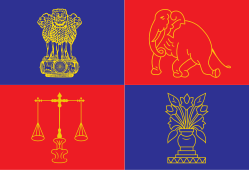 | 1950–1971[1] | Presidential Standard of India | 1st quarter: state emblem (the Lions of Sarnath) to represent national unity; 2nd quarter: elephant from Ajanta Caves to represent patience and strength; 3rd quarter: scales from the Red Fort, Old Delhi to represent justice and economy; 4th quarter: lotus vase from Sarnath to represent prosperity. |
Ensigns
| Flag | Date | Use | Description |
|---|---|---|---|
 | Civil ensign | A Red Ensign with the flag of India in the canton. | |
 | State ensign | A Blue Ensign with the flag of India in the canton, and a yellow anchor horizontally in the fly. |
Military flags
Army
| Flag | Date | Use | Description |
|---|---|---|---|
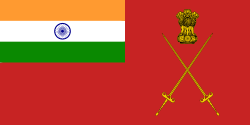 | Flag of the Indian Army | A red field with the flag of India in the canton, and the Army badge in the fly | |
 | Flag of the Chief of Army Staff |
Air Force
| Flag | Date | Use | Description |
|---|---|---|---|
 | Flag of the Indian Air Force | A sky-blue ensign with the flag of India in the canton, and the Air Force roundel in the fly | |
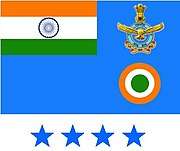 | Flag of the Chief of Air Staff | ||
.svg.png) | Flag of Marshal of the Indian Air Force |
Navy
| Flag | Date | Use | Description |
|---|---|---|---|
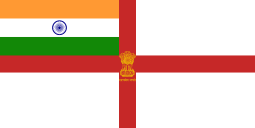 | Ensign of the Indian Navy | It is built up of the Indian National Flag, a Vertical and a Horizontal Red Stripe, the Indian State Emblem in golden yellow colour on a white background. | |
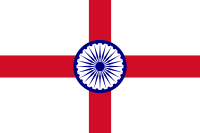 | Admiral (Chief of Naval Staff) | ||
 | Vice Admiral | ||
 | Rear Admiral | ||
| Commodore |
Coast Guard
| Flag | Date | Use | Description |
|---|---|---|---|
 | Ensign of the Indian Coast Guard | A Blue Ensign with the Flag of India in the canton, and the Coast Guard badge in the fly | |
 | Flag of Director General of the Indian Coast Guard | A Blue Ensign with the Flag of India in the canton, and the Coast Guard badge in the fly | |
 | Flag of Additional Director General of the Indian Coast Guard | ||
 | Flag of Inspector General of the Indian Coast Guard |
States and Union territorial flags
Official state flags
Jammu and Kashmir is the only state to have de jure flag.[2]
| Flag | State | Adopted | Use | Description |
|---|---|---|---|---|
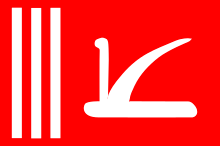 |
Jammu and Kashmir | 1972 | Flag of Jammu and Kashmir | The flag is red to symbolise labour, with three white vertical stripes in the hoist (which do not run the whole height of the flag). The stripes stand for the three divisions of the region namely; (Jammu, Kashmir, and Ladakh). On the right side of the flag is a white plough with the handle facing the stripes. The ratio of the flag to its width is 3:2. |
Non-official state flags
| Flag | State | Adopted | Use | Description |
|---|---|---|---|---|
.svg.png) | Sikkim | 1967 | The Flag of Sikkim was used as a de jure national flag while Sikkim was an independent kingdom prior to its integration with India in 1975 | Buddhist khorlo prayer wheel with the gankyil in the centre, on a field of white with a red border. |
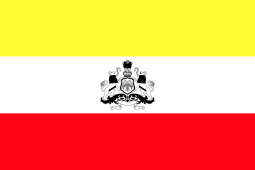 |
Karnataka | 2018 | Unilaterally adopted by the state government in 2018 [3] | Yellow, white and red tricolour with a representation of the Coat of arms of Karnataka centred on the white band. |
Historical
Pre-colonial states
| Flag | Date | Use | Description |
|---|---|---|---|
 | 647 - 1192 | Flag of Rajput Dynasty | A Saffron flag with a Sun symbol in the middle |
| 1206–1526 | Flag of Delhi Sultanate | A dark green flag with a black strip left of center. | |
| 1336 — 1646 | Flag of Vijayanagara Empire | Yellow coloured flag of the Vijayanagara Empire which ruled over South India. | |
 | 1729 — 1949 | Flag of Kingdom of Travancore | Red flag with a dextrally-coiled silver conch shell (Turbinella pyrum) at its centre. |
 | 1518–1687 | Flag of Kingdom of Golconda | Cyan coloured flag of the Qutb Shahi dynasty which ruled over the Kingdom of Golconda. |
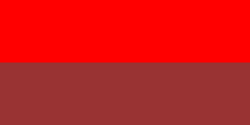 | 1399 — 1950 | Flag of Kingdom of Mysore | Red and Brown coloured flag of the Kingdom of Mysore which ruled over most of Karnataka and at its zenith most of south India. |
 | 1526–1858 | Flag of Mughal Empire | Alam flag that was primarily moss green.[4] |
| 1674–1818 | Flag of Maratha Empire (Bhagwa Dhwaj)[5] | A saffron-coloured swallowtail flag. | |
 | 1799–1849 | Flag of Sikh Empire[6] |
British Colonial India
| Flag | Date | Use | Description |
|---|---|---|---|
 | 1858–1947 | The official state flag of the British Empire for use in India | The flag of the United Kingdom. |
.svg.png) | c. 1885–1947 | Flag of the Governor-General of India | The Union Flag with the insignia of the Order of the Star of India beneath the Imperial Crown of India. |
.svg.png) | 1947–1950 | Dark blue field emblazoned with the royal crest (a Tudor Crown surmounted by the lion of England, itself wearing the crown), beneath which was the word 'India' in gold majuscules. Similar to flags used by other Governors-General of Commonwealth realms. | |
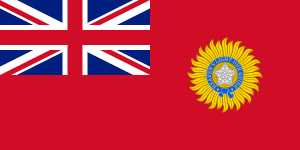 | c. 1880–1947 | Flag of the British Raj: A civilian flag used to represent British India internationally. | A Red Ensign with the Union Flag at the canton, and the Star of India displayed in the fly. |
(Royal) Indian Marine/(Royal) Indian Navy
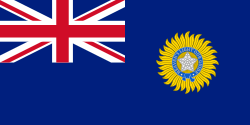 | 1863–1947 | 1877–1892 Ensign of Her Majesty's Indian Marine 1892-1928: Ensign of the Royal Indian Marine 1928–1934 Naval jack of the Royal Indian Marine 1934-1947: Naval jack of the Royal Indian Navy | A Blue Ensign with the Union Flag at the canton, and the Star of India displayed in the fly. |
 | 1928–1950 | 1928-1934: Ensign of the Royal Indian Marine 1934-1950: Ensign of the Royal Indian Navy | The White Ensign of the Royal Navy. |
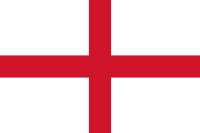 | 1951-1955 | 1951-1955: Flag of the Commander-in-Chief, Indian Navy 1955: Flag of the Chief of the Naval Staff of the Indian Navy | The St George's Cross. Ensign of an Admiral in the Royal Navy. |
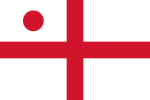 | 1934-1958 | 1934-1947: Flag of the Flag Officer Commanding, Royal Indian Navy 1947-1950: Flag of the Commander-in-Chief, Royal Indian Navy 1950-1955: Flag of the Commander-in-Chief, Indian Navy 1955-1958: Flag of the Chief of the Naval Staff of the Indian Navy | Ensign of a Vice-Admiral in the Royal Navy. |
 | 1928-1958 | 1928-1934: Flag of the Flag Officer Commanding, Royal Indian Marine 1934-1950: Flag of a Flag Officer, Royal Indian Navy 1950-1958: Flag of a Flag Officer, Indian Navy | Ensign of a Rear-Admiral in the Royal Navy. |
Danish India
 | 1620-1869 | The flag of Denmark (Denmark-Norway until 1814) |
French India
| Flag | Date | Use | Description |
|---|---|---|---|
 | 1667-1791 | Flag of the Kingdom of France | Flag of the Kingdom of France. |
.svg.png) | 1791-1794 | 1791-1792: Flag of the Kingdom of France 1792-1794: Flag of the French First Republic | The flag of France. |
.svg.png) | 1815-1830 | Flag of the Kingdom of France under the Bourbon Restoration | Flag of the Kingdom of France. |
 | 1794–1804, 1830-1940, 1944-1954 | 1794-1804: Flag of the French First Republic 1804-1814, 1815: Flag of the First French Empire 1830-1848; Flag of the Kingdom of France 1848-1852: Flag of the French Second Republic 1852-1870: Flag of the Second French Empire 1870-1940: Flag of the French Third Republic and French Empire 1944-1946: Flag of the Provisional Government of the Fourth French Republic 1946-1954: Flag of the French Fourth Republic and French Union | The flag of France. |
.svg.png) | 1940-1944 | Flag of French India under Free France | Flag of Free France with the Cross of Lorraine |
Portuguese India
| Flag | Date | Use | Description |
|---|---|---|---|
.svg.png) | 1505–1521 | Flag of the Kingdom of Portugal. | |
.svg.png) | 1521–1578 | Flag of the Kingdom of Portugal. | |
.svg.png) | 1578–1616 | Flag of the Kingdom of Portugal. | |
.svg.png) | 1616–1640 | Putative flag of the Kingdom of Portugal. | |
.svg.png) | 1640–1667 | Flag of the Kingdom of Portugal. | |
.svg.png) | 1667–1706 | Flag of the Kingdom of Portugal. | |
.svg.png) | 1706 - 1750 1826 - 1830 | Flag of the Kingdom of Portugal. | |
.svg.png) | 1750–1816 | Flag of the Kingdom of Portugal. | |
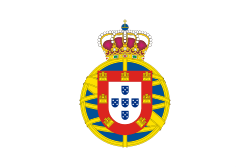 | 1816–1826 | Flag of the Kingdom of Portugal. | |
.svg.png) | 1830–1910 | Flag of the Kingdom of Portugal. | Vertical bicolour blue-white. Proportion of the fields: 1:1. |
 | 1911–1961 (de facto)/1974 (de jure) | The flag of Portugal. The final state flag of Portuguese India. | Used from the implantation of the Portuguese Republic in 1910. Officially used until 1974, as Portugal only then recognised the Annexation of Portuguese India. |
.svg.png) | 1967 (proposed) | Proposed official flag for Portuguese India in 1967. | Proposal by F.P. de Almeida Langhans. Never actually used. |
Flags used by the Indian independence movement
| Flag | Date | Use | Description |
|---|---|---|---|
.svg.png) | 1906 | Calcutta Flag | Three horizontal bands of equal width with the top being orange, the centre yellow, and the bottom green. It had eight half-opened lotus flowers on the top stripe, and a picture of the sun and a crescent moon on the bottom stripe. वन्दे मातरम् (Vande Mātaram) was inscribed in the centre in Devanagari. [Note 1] |
.svg.png) | 1907 | Early Indian nationalist flags [Note 2] | |
 | 1907 | ||
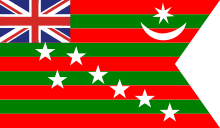 | 1917 | Flag of the Home Rule Movement | Five red and four green horizontal stripes On the upper left quadrant was the Union Jack, which signified the Dominion status that the movement sought to achieve. A crescent and a star, both in white, are set in top fly. Seven white stars are arranged as in the Saptarishi constellation (the constellation Ursa Major), which is sacred to Hindus. [Note 3] |
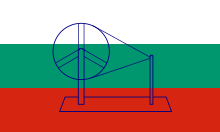 | 1921 | Gandhi's flag, introduced at the Indian National Congress meeting in 1921 | |
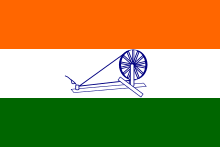 | 1923–1947 | The Swaraj Flag, officially adopted by the Indian National Congress in 1931 | |
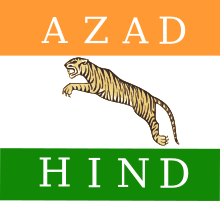 | 1942–1945 | Flag of Provisional Government of Free India | Three horizontal strips of saffron, white, and green, with a springing tiger in the center Although this symbolised the armed resistance of the Azad Hind Movement led by Subhas Chandra Bose (as opposed to Gandhian pacifism), the 1931 flag of the Indian National Congress was used when the Indian National Army hoisted its flag in Moirang, Manipur. Both flags were used interchangeably. |
See also
Notes
- ↑ The partition of Bengal (1905) resulted in the introduction of a new Indian flag that sought to unite the multitude of castes and races within the country. The Vande Mataram flag, part of the Swadeshi movement against the British, comprised Indian religious symbols represented in western heraldic fashion. The tricolour flag included eight white lotuses on the upper green band representing the eight provinces, a sun and a crescent on the bottom red band, and the Vande Mataram slogan in Hindi on the central yellow band. The flag was launched in Calcutta bereft of any ceremony and the launch was only briefly covered by newspapers. The flag was not covered in contemporary governmental or political reports either, but was used at the annual session of the Indian National Congress. A slightly modified version was subsequently used by Madam Bhikaji Cama at the Second Socialist International Meeting in Stuttgart. Despite the multiple uses of the flag, it failed to generate enthusiasm amongst Indian nationalists.[7]
- ↑ Around the same time, another proposal for the flag was initiated by Sister Nivedita, a Hindu reformist and disciple of Swami Vivekananda. The flag consisted of a thunderbolt in the centre and a hundred and eight oil lamps for the border, with the Vande Mataram caption split around the thunderbolt. It was also presented at the Indian National Congress meeting in 1906.[8] Soon, many other proposals were initiated, but none of them gained attention from the nationalist movement.
- ↑ In 1916, Suraiya Tayyabji submitted thirty new designs, in the form of a booklet funded by members of the High Court of Madras. These many proposals and recommendations did little more than keep the flag movement alive. The same year, Annie Besant and Bal Gangadhar Tilak adopted a new flag as part of the Home Rule Movement. The flag included the Union Jack in the upper left corner, a star and crescent in the upper right, and seven stars displayed diagonally from the lower right, on a background of five red and four green alternating bands. The flag resulted in the first governmental initiative against any nationalistic flag, as a magistrate in Coimbatore banned its use. The ban was followed by a public debate on the function and importance of a national flag.[9]
References
- ↑ Das, Chand N. (1984). Traditions and Customs of the Indian Armed Forces. Vision Books. p. 53.
- ↑ Haynes, Ed (24 September 1996). "Jammu and Kashmir (India)". Flags of the World. Retrieved 22 October 2010.
- ↑ "Karnataka government unveils the state flag, awaits Centre's approval". hindustantimes.com/. 2018-03-08. Retrieved 2018-03-08.
- ↑ http://www.bl.uk/onlinegallery/onlineex/apac/addorimss/a/zoomify55414.html
- ↑ Kadam, Vasant S. (1993), Maratha Confederacy: A Study in Its Origin and Development, Munshiram Manoharlal Publishers, p. 128, ISBN 978-81-215-0570-3
- ↑ http://www.sikhmuseum.com/nishan/empire/architecture.html#arch4
- ↑ Virmani 1999, pp. 175–176
- ↑ Roy 2006, pp. 498–499
- ↑ Virmani 1999, pp. 176–177
External links
- "India - Index of all Pages".
- "Indian Ensigns".
- "British Rule in India".
- "India: Historical Flags". Flags of the World. Retrieved 2010-10-22.
This article is issued from
Wikipedia.
The text is licensed under Creative Commons - Attribution - Sharealike.
Additional terms may apply for the media files.